
It is wine time: Meet the new competition
APVSA Introduces Wine-Entrepreneurs to Global Markets
The Association for the Promotion of Wines and Spirits in North America (APVSA), headquartered in Montreal, Canada, provides assistance to European wine and spirits producers who want to export their products – especially to North America. To reach this objective, the association schedules 6 tours per year primarily in the USA, Canadian and European markets.

Most of the wines presented at the recent NY event were French, representing small, relatively unknown wineries producing quality wines. The wineries are interested in locating importers so that their wines are available in the American and other international markets. The Association has direct access to a portfolio of 5000+ buyers as well as the ability to participate in 46 annual tastings in 34 different cities. Through the efforts of the organization, 200 winemakers are distributing their wines to the USA and Canada.
I am always on the prowl for what is new and wonderful – and was not disappointed at the recent APVSA presentation.
Curated January 2019 APVSA Wine Event. New York City
- Champagne Sourdet Diot
Located in the Marne Valley in La Capelle Monthdon, the Sourdet vineyards cover 11 hectares of grapes on southeast facing slopes. The first vines were planted by Raymond Sourdet in the 1960s and the grapes were sold to Veuve Cliquot. In 1980, Patrick and Nadine Sourdet decided to retain 50 percent of the harvest for their own Champagne production and installed a traditional press and cellars. In 1990 their contract with Veuve Cliquot was not renewed and since then the entire harvest has been used to produce Champagne Sourdet Diot.
In 2003, Ludivine and her husband Damien joined the family business and as members of the French Federation of Independent Winegrowers focus on creating a quality Champagne.
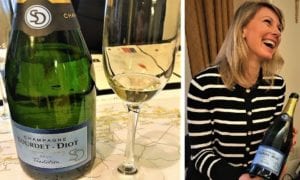
Champagne Sourdet Diot Brut Tradition. Marne Valley. 70 % Pinot Meunier, 30% Chardonnay
Notes. Pale gold to the eye with thin bubbles. An aroma of brioche delights the nose along with hazelnuts and apples.
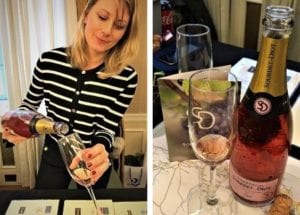
Champagne Sourdet Diot. Rosé Brut. 60 % Pinot Meunier, 30 % Chardonnay. 10% Champenoix (wine vinified in oak for 2 years and composed of 50 % Pinot Noir and 50% Pinot Meunier)
Notes. Coral pink to the eye and a light cherry aroma is detected. Look for red fruits delivered to the palate. Although it is sweet to the palate it is pleasant and refreshing as the minerality tempers the sweetness. Perfect for Birthday and Anniversary celebrations.
- Bayle Carreau. Cremant de Bordeaux. Blanc Brut
The wineries are located in the Bordeaux region within the Blaye Cotes de Bordeaux and Cotes de Bourg geographical region and part of the Grads Vins de Bordeaux family. Since the beginning of the 19th century the wine estates have enjoyed clay and limestone terroir. The mild climate and location to the Girone estuary contributes to growing exceptional grapes. Five generations of vigerons and winemakers have developed an ambitious family-owned business. Since 2003 the wines have been available in the Chinese market and are now sold in the US, Mexico, Japan and Russia.
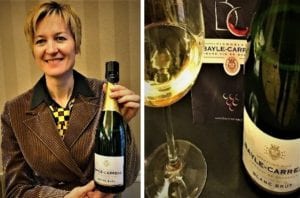
Bayle-Carreau. Blanc Brut Appellation. Côtes de Bourg. Grapes. Pinot Meunier, Chardonnay
Notes. To the eye, light (almost transparent) yellow/green. The nose senses Fiji apples with hints of lemons and limes. The palate is delighted with light bubbles that delivers lots of fruit that is sweet but not cloying.
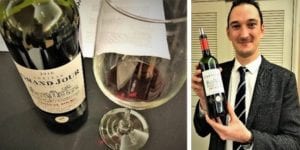
- 2016 Chateau Grand Jour. Region. Cotes de Bordeaux. Winery. Jean Guillot. Matured between 12-18 months in oak barrels (20 %) and stainless steel (80%).
Source of Grand Jour? When kings ruled the country, “grand journals” were courts established by the parliaments and chaired by a royal commissioner and responsible for deciding criminal and civil offenses. They also restored order and civil peace in the provinces, including Bordeaux. In the mid-15th century, the English, who had occupied Aquitaine for more than 100 years, were defeated by the troops of the French King Charles VII of Castillon on the Gironde. The winemakers in Bordeaux, who until then sold all their wine to England, saw the demise of their export market and threatened their prosperity.
Notes. The Chateau Grand Jour is a blend of Merlot, Cabernet Sauvignon and Cabernet Franc. The Merlot brings softness and spicy notes to the palate while the Cabernet Sauvignon delivers structure and gentle tannins and the Cabernet Franc contributes fruitiness.
Dark red to purple velvet to the eye, the nose finds warm leather, wood and rich soil, plums, vanilla and candied cherries. Light and fruity on the palate like fresh dark cherries on a summer afternoon. A long tart cherry experience lingers until the next sip.

- Pineau Francois 1er. Producer: Gaston Riviere
If you like a wine that is sweet and strong (Vin de Liqueur) from the Cognac region of western France, you will be delighted with Pineau Francois 1er. It is made by adding Cognac eau-de-vie from the previous year’s (or older) distillation to fresh grape must of the current vintage.
To follow the letter of the law, the must is required to be freshly harvested and the Cognac must have an alcohol level of at least 60 percent. The result? Alcoholic strength of 16-22 percent and a sugar content of at least 125 g/L. The must remain unfermented and therefore retains all of its grape flavors.
All Pineau des Charentes is aged at the winery for a minimum of 18 months – including 12 months in oak barrels. If the label says “old” (vieux), the wines must spend 5+ years in oak. To be considered “very old” (tres vieux), the wine must stay in the barrel for a full 10 years. The wines are mostly from Charentais grape varieties: Ugni Blanc, Colombard, Folle Blance, Jurancon Blanc and Montil (also known as Aucarot and Chalosse).
The Pineau des charentes title started in 1945 and has been useful for wines not used for Cognac. The connection between Cognac and Pineau des Charentes works well as it allows for both hot vintages (when acid levels may fall too low to be adequate for Cognac) and cool vintages (when the grapes may struggle to ripen sufficiently for use in table wines).
Pineau Francois 1er entered the market in February 1934 by Gaston Riviere. It received a gold medal at the Foire Internationale de la Rochelle – a prize of Excellence at the 24th enologists’ congress, selected from 1100 different high-quality wines. It also received first place in the Hachette des vins guide.
Notes. To the eye – clear with hints of yellow sunshine.. The nose finds the sweetness of fruit, warm honey and lemons. The vicous texture on the palate is pleasant and the long finish to desirable.

- Champagne Charles Clement Blanc de Blancs. Appellation: Champagne, Department of Aube, southeast of the Champagne appellations. Soil: Clay-limestone on the hillsides with south-southwest exposure. Varietal: 100% Chardonnay, 20% reserve wines (from previous harvests). Manual harvest in traditional boxes of 40 kg. Vinification in stainless steel tanks. Malolactic fermentation. Aging on lees for 3 years before disgorging.
Notes: Light yellow color with green tones. The nose find aromas of fresh citrus. The palate finds citrus, especially grapefruit, and lime. Fine bubbles are delightful and playful on the palate. Ends with a delicate note that is fresh and fruity.

- Champagne Malard. 40% Pinot Noir, 40% Pinot Meunier and 20% Chardonnay (exclusively grown in the 43 villages permitted to produce Premier Crus, mainly from Epernay).
Started in 1996 by Jean-Louis Malard, Malard House is located in Ay-Champagne, a village known for the Grands Crus de Noirs in the Montagne de Reims and center for many internationally recognized Champagne organizations. Malard was born in Epernay, the capital city of Champagne and the organization is independently owned and operated.
Malard grapes are from Premier Crus and Grand Crus grapes. The vat facilities are located in Oiry, a Grand Cru village in the famous Cote des Blancs. The facilities and cellars are spread over more than 5000 m2 with a capacity of 8000 hectoliters.
Notes. Palest of yellow to the eye with the smell of fresh grass and meadows to the nose. Very light fizz that disappears quickly leaving a fresh minerality to the palate. Perfect for spring and summer afternoons or as an aperitif before dinner.
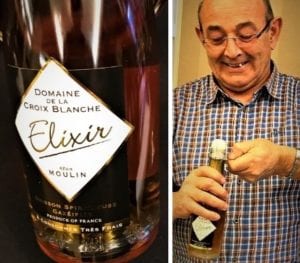
- Domaine de la Croix Blanche Elixir
The vineyard covers 27 hectares and is located in Macqueville in Charente-Maritime (near Cognac). The Domaine de la Croix Blance has been family owned and operated since 1931. The vineyard is managed by Regis Moulin who brings 50 years of experience to the vineyard. He produces Pineau des Charentes and Cognac that is distilled on site, as well as Cognac liquor – considered a rare product. The estate follows agro-environmental standards and governed by classified facilities for the protection of the environment (ICPE).
Notes. Clear to the eye with bright yellow sunlight. The nose finds black and yellow raisins, plums, oranges and the palate is delighted with the viscous texture that delivers sweet fruitiness. Although the Elixir is very sweet the overriding observation is that it is delicious. Perfect as an aperitif or desert.
The Event.
Dozens of writers, wine buyers, and sellers spent the day, discovering new and wonderful wines for their shops, restaurants, wine bars and collections.


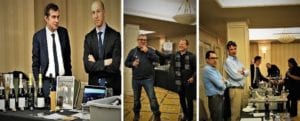
For additional information: https://apvsa.ca/en/
